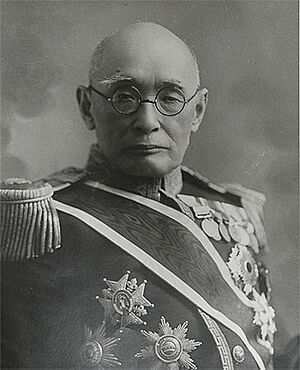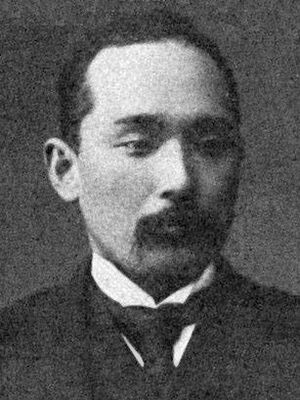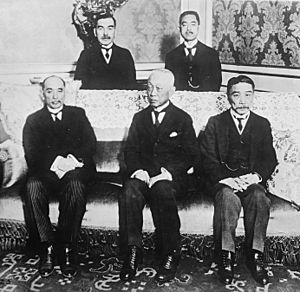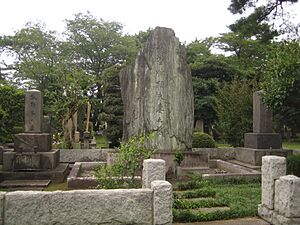Makino Nobuaki facts for kids
Quick facts for kids
Count
Makino Nobuaki
牧野 伸顕 |
|
|---|---|
 |
|
| Lord Keeper of the Privy Seal of Japan | |
| In office 30 March 1925 – 26 February 1935 |
|
| Monarch | |
| Preceded by | Hamao Arata |
| Succeeded by | Saitō Makoto |
| Foreign Minister of the Japanese Empire | |
| In office February 1913 – April 1914 |
|
| Monarch | Taishō |
| Preceded by | Katō Takaaki |
| Succeeded by | Katō Takaaki |
| Personal details | |
| Born | November 24, 1861 Kagoshima Prefecture, Japan |
| Died | January 25, 1949 (aged 87) Tokyo, Japan |
| Parents | Ōkubo Toshimichi Hayasaki Masako |
| Occupation | Politician, cabinet minister, diplomat |
Count Makino Nobuaki (born November 24, 1861 – died January 25, 1949) was an important Japanese politician and advisor. He was also known as Makino Shinken. He served as the Lord Keeper of the Privy Seal of Japan. This meant he was a main advisor to Emperor Hirohito about Japan's government and policies.
After World War I, Makino helped represent Japan at the Paris Peace Conference in 1919. Here, he and others suggested a plan for racial equality. Most countries agreed, but the chairman, President Woodrow Wilson, said no.
Even after he retired in 1935, he stayed a close advisor to the Emperor. He tried to prevent Japan from going to war with China and the United States. He also supported the idea of Japan becoming a country with a democratic government.
Contents
Makino's Early Life and Schooling
Makino was born into a samurai family in Kagoshima. This area was once called the Satsuma Domain. He was the second son of Ōkubo Toshimichi, a very important leader. However, Makino was adopted into the Makino family when he was very young.
In 1871, when he was 11, Makino traveled to the United States. He went with Ōkubo Toshimichi as part of the Iwakura Mission. This was a group of Japanese leaders who visited Western countries to learn about their ways. Makino briefly went to school in Philadelphia. After returning to Japan, he studied at Tokyo Imperial University, but he did not finish his degree.
Makino's Career as a Diplomat
Makino started his career as a diplomat. His first job was at the Japanese Embassy in London. There, he met Itō Hirobumi, another very important Japanese leader. After working abroad, Makino became a governor in Japan. He was governor of Fukui Prefecture from 1891 to 1892. Then he was governor of Ibaraki Prefecture from 1892 to 1893.
He later returned to diplomacy. He served as Japan's Ambassador to Italy from 1897 to 1899. After that, he was Ambassador to the Austro-Hungarian Empire and Switzerland.
Important Government Roles
In March 1906, Makino became the Minister of Education. He worked under Prime Minister Saionji Kinmochi. While in this role, he was given the title of danshaku, which means baron. This was part of the kazoku system, a special rank for noble families.
When Saionji Kinmochi became Prime Minister again in 1911, Makino joined his government. He became the Minister of Agriculture and Commerce. He also joined the Privy Council, a group of advisors to the Emperor. Makino often supported the ideas of Itō Hirobumi and Saionji Kinmochi. He was seen as an early leader of the Liberalism movement in Japan. This movement supported more freedom and rights for people.
After Japan won World War I, Makino was chosen to represent Japan at the Paris Peace Conference in 1919. He was one of Japan's main representatives, working with Marquis Saionji. At the conference, Makino and his team suggested a plan for racial equality. This idea meant that all races should be treated equally. Most countries at the conference voted for it. However, the chairman, President Woodrow Wilson of the United States, stopped it from passing.
In 1920, Makino received a high honor called the Grand Cordon of the Order of the Rising Sun. In 1921, he became the Imperial Household Minister. His rank was also raised to shishaku, meaning viscount. He worked hard to improve Japan's relationships with Britain and the United States. He also tried to keep the Emperor from getting too involved in politics. Some historians believe this made the Emperor less likely to stop Japan's military from becoming too powerful.
Later Political Influence
In 1925, Makino was appointed Lord Keeper of the Privy Seal of Japan. He helped organize the ceremony for Emperor Hirohito to become Emperor in 1928. On May 15, 1932, Makino's home was attacked by a group of ultra nationalists. This was part of an event called the May 15 Incident. Luckily, Makino was not hurt.
In 1935, he left his job as Lord Keeper. His title was raised again to hakushaku, which means count. Even though he officially retired, he remained a close friend and advisor to Emperor Hirohito. He still had a lot of power and influence behind the scenes. This made him a target for extreme military groups in Japan. He barely escaped being killed during the February 26 Incident in 1936. This was a time when some military officers tried to take over the government. Makino continued to advise the Emperor and tried to encourage peaceful actions until World War II began.
Later Life and Passing
Makino was also the first president of the Nihon Ki-in Go Society. He loved playing the game of go.
After World War II, Makino was seen as a "liberal" leader. This meant he believed in freedom and individual rights. Because of this, he was highly respected. A politician named Ichirō Hatoyama asked him to lead the Liberal Party. However, Makino said no because of his age and health. He passed away in 1949. His grave is in the Aoyama Cemetery in Tokyo.
Makino's Family Connections
Makino had many important family members. Shigeru Yoshida, who became a Prime Minister after the war, was Makino's son-in-law. One of his grandchildren, Ken'ichi Yoshida, was a famous writer. The former Prime Minister, Tarō Asō, is Makino's great-grandson. Makino's great-granddaughter, Nobuko Asō, married Prince Tomohito of Mikasa. He was a cousin of Emperor Akihito. Also, Ijūin Hikokichi, a former foreign minister, was Makino's brother-in-law.
Honors and Awards
- 1925: Grand Cordon Order of Leopold (from Belgium).
- 1930: Grand Cross of the Order of the White Lion (from Czechoslovakia).
Images for kids





